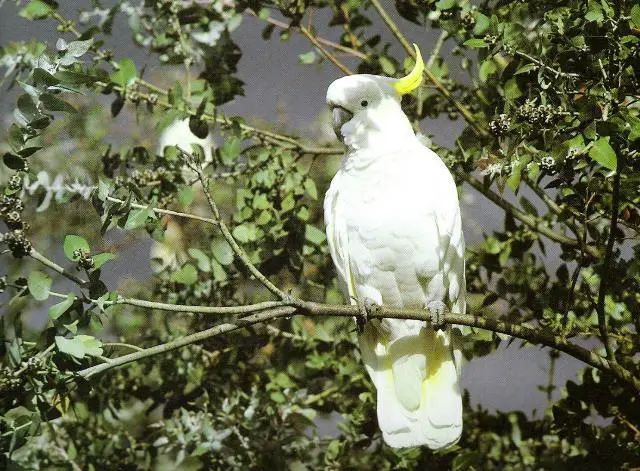The sulphur-crested cockatoo (Cacatua galerita) is a medium-sized cockatoo that occurs in the woody forests of New Guinea, Australia, and the islands of Indonesia. They are fairly common in much of its range but are thought to be pests. Sulphur-crested cockatoos are emotionally demanding but they usually make good pets.
Sulphur Crested Cockatoo Facts
Anatomy
- The sulphur crested cockatoo grows to a total length of 44–55 cm (17–22 in). The Australian subspecies are larger than those living in the New Guinea or Indonesian islands.
- Cockatoos have wingspan 28 – 32 inches.
- They have absolutely white plumage but the tail is slightly yellow. Cockatoos are recognized by the grey legs and black bill.
- Male cockatoos have completely black eyes whereas females have reddish brown eyes.
- Sulphur-crested cockatoos resemble corellas of Australia not only in the physical appearance but somewhat in behavior.
- They have got prominent yellow-crested feathers just above the head.
Distribution & Habitat
- Sulphur-crested cockatoos are most likely to occur in the suburban habitats of Australia. In Australia, they are mainly found in Canberra, Adelaide, Brisbane, Sydney, Melbourne, to as far as Tasmania.
- Some of the isolated population is also found in New Guinea as well as occupying small islands of Milne Bay, Cenderawasih Bay, Misool, and Aru.
- Cockatoo’s habitats include woodland forests, eucalyptus forests, savanna woodland, coastal mangroves, and cultivated cropland. In New Guinea they live in lowland forests up to an elevation of 1,400 meters. However they also occur in highland forests of 4,950 – 7,920 m.

Feeding Ecology & Diet
- Cockatoos typically feed on seeds, bulbous roots, grains, nuts, leaf buds, herbaceous plants, and berries. They eat either in large groups or small groups but never feed alone. Not all members of the group eat at once as few of them watch out external threats while others eat.
- They often engage in biting off branches of trees and barks if not busy eating fruits.
Behavior
- Cockatoos in general are very noisy as they have a loud raucous call.
- They do move around tropical and subtropical rainforests to observe the forest environments.
- They are not only curious but are highly intelligent creatures.
- Over the years, cockatoos have adapted to live in many urban areas.
- They will travel several kilometers in search of food but rarely go too far from the roosting site.
- While they spend most of the day feeding, cockatoos typically avoid the hottest hours of the day during which they seek shelter.
Reproductive Biology
- They are not regular breeders in New Guinea and as such their breeding behavior is rarely observed. However in southern Australia, cockatoos breed from August to January. The northern subspecies are likely to breed from May to September.
- They make nests in a tree hollow. Cockatoos are thought to compete with other species for nesting.
- A female cockatoo lays 2 – 3 eggs. Both parents incubate the eggs that last about 3 – 4 weeks.
- The chicks remain in the nest for about 63 – 84 days but they stay with parents months after fledging.
- The breeding interval is one year.
- Cockatoos attain maturity at 2 to 4 years age.
- Sulphur-crested cockatoos are one of the longest lived parrots. In captivity, they can live up to 70 years while in the wild cockatoo’s lifespan is about 20 – 40 years. The oldest sulphur-crested cockatoo ever lived in captivity named ‘Cocky’. It lived up to 82 years.
- Like most other birds, cockatoos are also able to generate oil within themselves that could waterproof the skin.






Leave a Reply